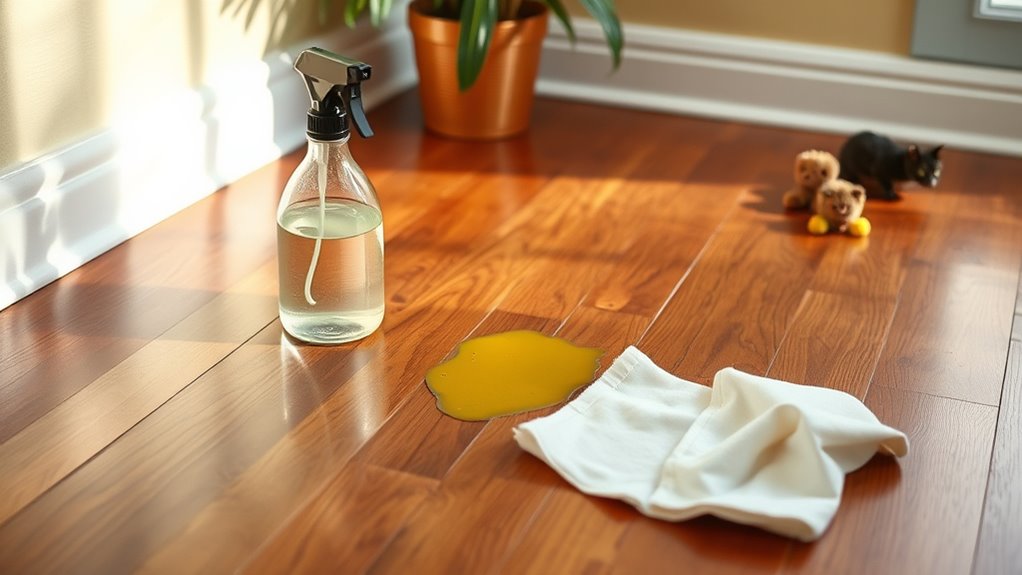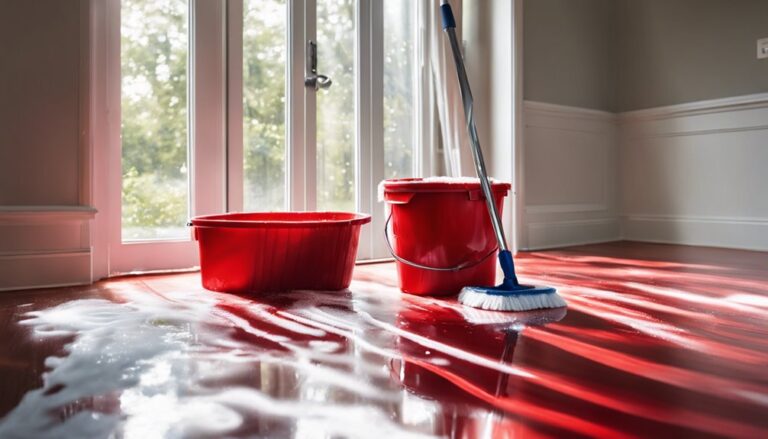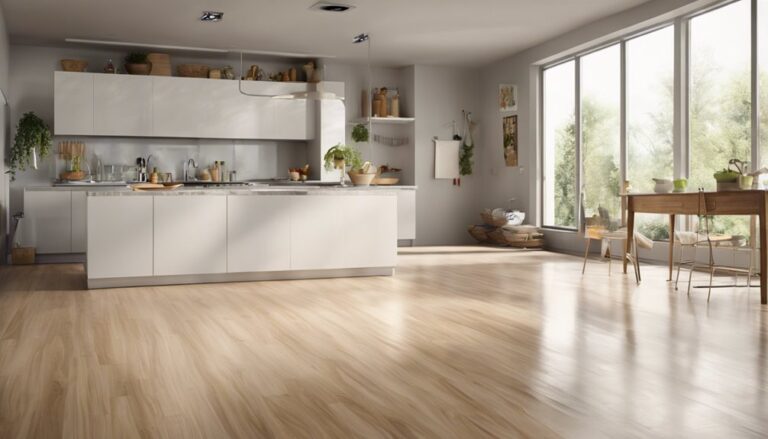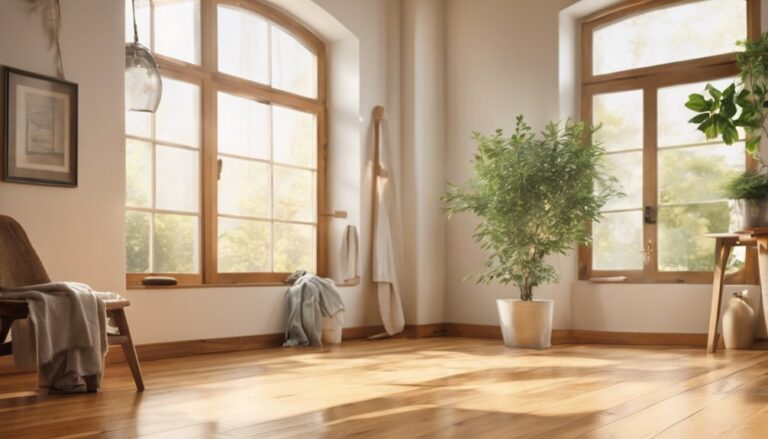To get cat pee out of hardwood floors, first blot the area gently with paper towels without rubbing, then ventilate the room well. Use an enzymatic cleaner designed for pet urine to break down odors and stains, letting it sit 10–15 minutes before blotting excess moisture. Avoid harsh chemicals like ammonia and test all products on a hidden spot to protect your floor’s finish. For natural alternatives, try diluted vinegar or baking soda. Keep going to explore thorough methods and prevention tips.
Identifying Cat Urine on Hardwood Floors
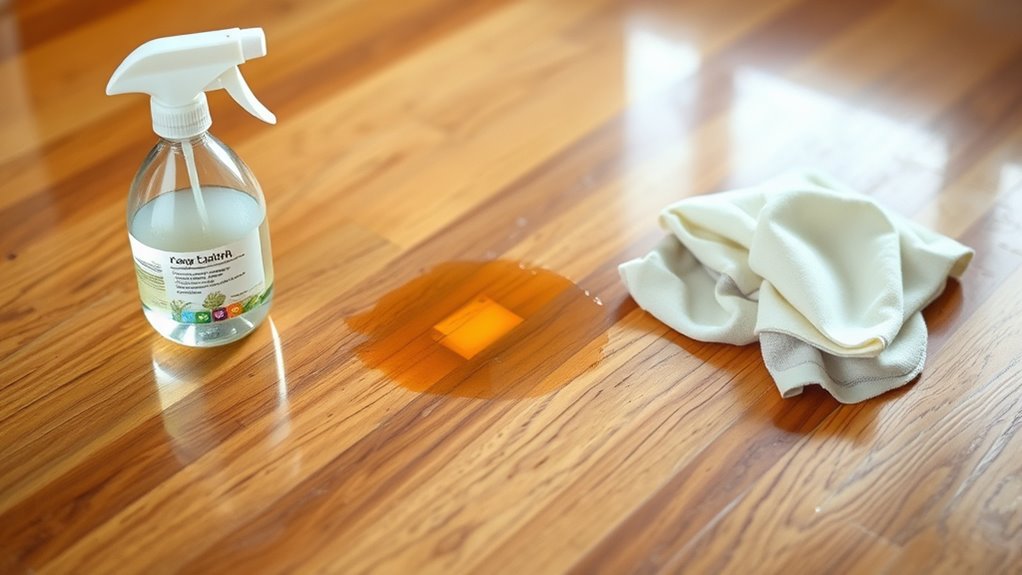
Detecting cat urine on hardwood floors can be tricky since it often soaks into the wood, leaving subtle signs. You’ll want to carefully inspect different floor types since porous woods absorb liquids differently, affecting odor and staining. Pay close attention to areas where your cat’s behavior indicates stress or territorial marking, such as near doors or corners. Use a blacklight in a dim room to reveal urine spots, which glow under UV light. Remember, early identification is essential to prevent long-term damage and lingering odors. Prioritize safety by ventilating the area while inspecting and avoid harsh chemicals that could harm your pet or finish. By understanding cat behavior and floor types, you equip yourself to spot hidden accidents confidently, preserving your freedom to enjoy your space odor-free.
Immediate Steps to Take After an Accident
As soon as you notice the accident, use a clean cloth or paper towels to blot up as much moisture as possible without rubbing, which can spread the urine. Next, open windows or turn on fans to ventilate the area thoroughly, helping to reduce odors and speed up drying. Taking these immediate steps is vital to prevent damage and minimize lingering smells.
Blot Up Moisture
Start by immediately blotting up the cat urine using paper towels or a clean, absorbent cloth. This blot technique maximizes moisture absorption and prevents the liquid from seeping deeper into the wood. Press firmly but avoid rubbing, which can spread the stain and damage the finish. Change towels frequently until no more moisture transfers.
| Step | Action | Purpose |
|---|---|---|
| 1 | Blot urine with paper towel | Absorb surface moisture |
| 2 | Apply pressure gently | Enhance moisture absorption |
| 3 | Replace towels as needed | Prevent re-wetting |
| 4 | Use clean cloth if available | Avoid contamination |
| 5 | Dispose used towels safely | Maintain hygiene |
Following this method guarantees swift containment, preserving your hardwood’s integrity and your freedom from lingering odors.
Ventilate the Area
Once you’ve blotted up the urine, you’ll want to ventilate the area thoroughly to help dissipate odors and reduce moisture buildup that could damage your hardwood floors. Open windows and doors to create strong air circulation, allowing fresh air to flow freely across the affected spot. If possible, use a fan directed at the area to accelerate drying and enhance ventilation. Proper air circulation prevents lingering smells and inhibits mold growth, which can compromise your floor’s integrity. Avoid using humidifiers, as added moisture defeats your goal. Make sure to keep pets and children away during this process for safety. By prioritizing fresh air and airflow, you protect your floors while maintaining a healthy indoor environment free from stubborn cat pee odors.
Gathering the Right Cleaning Supplies
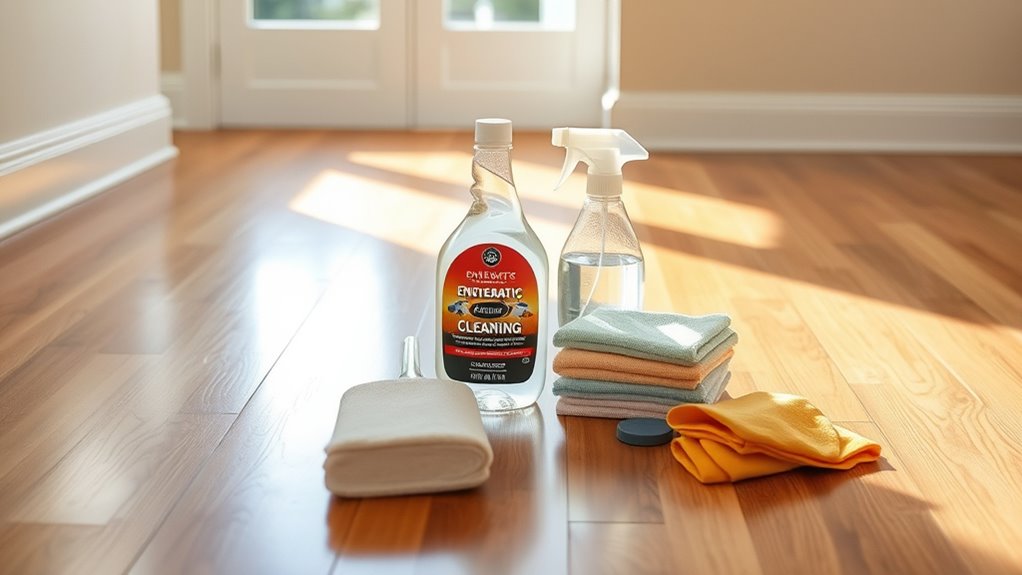
Before you start cleaning, make certain you have the essential products like enzymatic cleaners, white vinegar, and microfiber cloths. Don’t forget to wear protective gloves to avoid skin irritation from cleaning agents. Having everything ready guarantees a safe and effective removal of cat urine from your hardwood floors.
Essential Cleaning Products
Effective removal of cat urine from hardwood floors hinges on having the right cleaning products at hand. You’ll need enzymatic cleaners specifically designed to break down urine proteins, which are vital for thorough odor elimination. Avoid harsh chemicals that can damage your wood finish. Alongside these, prepare pH-neutral hardwood floor cleaners to safely clean without stripping the surface. Essential cleaning tools include microfiber cloths for gentle wiping, soft-bristle brushes for scrubbing, and a spray bottle to apply solutions evenly. Make sure your chosen products are non-toxic and safe for indoor use, protecting both you and your pet. By equipping yourself with these targeted cleaning products and tools, you can confidently restore your floors and reclaim your space free from lingering odors.
Protective Gear Needed
Although having the right cleaning products is essential, protecting yourself with appropriate gear is equally important when tackling cat urine on hardwood floors. You’ll want to minimize contact with harsh chemicals and bacteria by gearing up properly.
Make sure you have:
- Protective gloves: Choose durable, chemical-resistant gloves to shield your skin from irritants and contaminants.
- Safety goggles: Protect your eyes from splashes and airborne particles during cleaning.
- A mask or respirator: To avoid inhaling fumes from cleaning agents or bacteria.
Wearing this gear not only safeguards your health but also lets you clean confidently and efficiently. Don’t skip this step—your freedom to breathe easy and stay safe depends on it.
Using Enzymatic Cleaners for Deep Cleaning
When tackling cat pee stains on hardwood floors, using enzymatic cleaners is essential because they break down the urine’s organic compounds at a molecular level, ensuring thorough removal of odors and preventing your cat from returning to the same spot. To maximize enzymatic benefits, apply the cleaner generously, ensuring it penetrates any cracks or seams. Let it sit for the recommended time—usually 10 to 15 minutes—to allow enzymes to work effectively. Avoid rinsing immediately; instead, blot excess moisture with a clean cloth. Always test the cleaner on a small, hidden area first to confirm hardwood compatibility and wear gloves to protect your skin. This targeted approach not only eliminates stains but also disrupts marker scents, giving you freedom from repeat accidents and maintaining your floor’s integrity.
Homemade Solutions for Removing Cat Urine
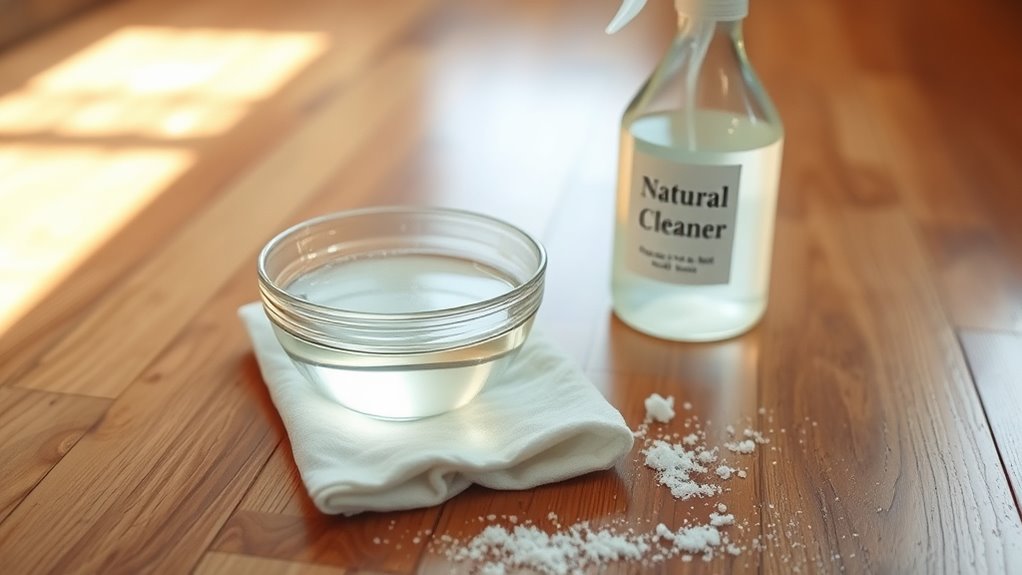
You can effectively tackle cat urine stains on hardwood floors using homemade solutions like a vinegar and baking soda mixture or a hydrogen peroxide blend. Be sure to follow precise measurements and test any solution on a small area first to avoid damaging the wood finish. Adding a few drops of essential oils can help neutralize odors, but always prioritize safety by using non-toxic, pet-friendly oils.
Vinegar and Baking Soda
Two common household ingredients, vinegar and baking soda, create a powerful, natural solution for neutralizing cat urine odors and stains on hardwood floors. Vinegar benefits include its acidity, which breaks down uric acid crystals, while baking soda absorbs moisture and neutralizes odors. To use this method safely and effectively:
- Mix one cup of white vinegar with one cup of warm water. Apply gently to the affected area.
- Let it sit for 5-10 minutes, then blot dry with a clean cloth.
- Sprinkle baking soda liberally over the damp area and leave it for several hours or overnight before vacuuming.
Always test a small hidden spot first to verify no discoloration. This approach respects your floor’s finish while giving you freedom from harsh chemicals.
Hydrogen Peroxide Mixture
Although hydrogen peroxide is a potent cleaner, it must be used cautiously on hardwood floors to avoid damage. To harness its cleaning effectiveness, mix 3% hydrogen peroxide with a teaspoon of mild dish soap in a spray bottle. Test this mixture on a hidden spot first to verify it won’t discolor or dull your floor’s finish. Lightly spray the affected area—don’t saturate the wood—and let it sit for about 5–10 minutes. Then, gently blot with a clean cloth, avoiding abrasive scrubbing that might harm the wood. Hydrogen peroxide breaks down urine stains and neutralizes odors effectively, but overuse can strip the finish. Always dry the floor thoroughly afterward. This method gives you powerful stain removal while preserving your hardwood’s integrity and your freedom from lingering odors.
Essential Oil Additives
Several essential oils can be effective additives when creating homemade solutions for cat urine removal, thanks to their natural antibacterial and deodorizing properties. You can harness essential oil benefits as natural alternatives to harsh chemicals, enhancing both cleaning power and scent. When mixing your solution, add just a few drops of these oils to avoid damaging your hardwood floors:
- Tea Tree Oil: Known for its strong antibacterial effects, it helps neutralize odor-causing bacteria.
- Lavender Oil: Offers a pleasant scent while providing mild antiseptic properties.
- Eucalyptus Oil: Acts as a powerful deodorizer and antimicrobial agent.
Always dilute essential oils properly and test on a small area first to confirm your floor’s finish isn’t compromised. Using these natural alternatives lets you clean effectively while maintaining a healthy, chemical-free environment.
Avoiding Common Cleaning Mistakes
When cleaning cat pee from hardwood floors, you’ll want to steer clear of common mistakes that can worsen the damage or make odors linger. First, avoid using harsh chemicals or ammonia-based cleaners, as they can damage the wood finish and confuse your cat’s scent markers. Instead, stick to recommended cleaning techniques that gently lift stains without harming the flooring. Don’t oversaturate the wood; excessive moisture can seep into cracks and cause warping or mold. Mistake prevention also includes promptly blotting the area rather than rubbing, which spreads urine deeper. Finally, always test any cleaner on a small, hidden spot to verify it won’t discolor your floors. By following these guidelines, you maintain your hardwood’s integrity and keep your home fresh and inviting.
How to Neutralize Odors Effectively
After you’ve carefully cleaned the cat pee from your hardwood floors without causing damage, the next step is to neutralize any lingering odors. Effectively tackling the smell means using proven odor absorption techniques and natural odor neutralizers that won’t harm your floors or health. Here’s how to proceed safely and efficiently:
- Baking soda application: Sprinkle a generous layer over the affected area and let it sit for several hours to absorb odors naturally.
- White vinegar solution: Lightly mist diluted vinegar onto the spot; it neutralizes ammonia smells without damaging finish.
- Activated charcoal: Place bowls nearby to absorb airborne odors and maintain freshness.
These methods guarantee your home stays odor-free while preserving your hardwood’s integrity, giving you the freedom to enjoy a clean, fresh space confidently.
Preventing Future Cat Pee Incidents
Although you’ve successfully cleaned and neutralized odors from your hardwood floors, preventing future cat pee incidents requires proactive measures. Understanding cat behavior is essential; cats often avoid soiled litter boxes or areas that feel unsafe. Guarantee you maintain a clean, accessible litter box in a quiet spot, promoting effective litter training. Use unscented, clumping litter to encourage use, and scoop daily to prevent aversion. Monitor your cat’s health, as urinary issues can prompt inappropriate urination. Additionally, minimize stressors like changes in routine or new pets, which disrupt behavior. Consider pheromone diffusers to create a calming environment. By combining attentive litter training with respect for your cat’s natural instincts and safety, you’ll reduce the risk of accidents, preserving your freedom and your hardwood floors.
When to Call a Professional Cleaner
There are several clear signs that indicate it’s time to call a professional cleaner for cat pee on hardwood floors. Knowing when professional intervention is necessary can save your floors from irreversible damage and lingering odors. You’ll want to seek expert help if you notice:
- Persistent odors despite thorough cleaning, signaling deep urine penetration.
- Visible discoloration or warping of wood that home remedies can’t fix.
- Signs needing assistance with sanitization, especially if your cat’s urine has soaked into cracks or seams.
Professionals use specialized products and techniques ensuring safe, effective removal without compromising your floor’s finish. Don’t risk your hardwood’s integrity or your health by delaying. If you recognize any of these signs needing assistance, contacting a cleaner experienced with pet stains guarantees your flooring stays beautiful and odor-free, giving you the freedom to enjoy your home worry-free.
Maintaining Hardwood Floors After Cleaning
Once you’ve thoroughly cleaned cat urine from your hardwood floors, maintaining their condition requires consistent care and attention to prevent future damage and odors. For effective floor maintenance, start by regularly sweeping or vacuuming to remove debris that can scratch the surface. Use a damp mop with a pH-neutral cleaner designed for hardwood—avoid harsh chemicals that strip finishes or cause discoloration. Implement preventive measures like placing mats near litter boxes and training your cat away from sensitive areas to minimize accidents. Ascertain proper ventilation to reduce moisture buildup, which can warp wood. Periodically inspect your floors for signs of damage or lingering odors, addressing issues immediately. By following these steps diligently, you’ll protect your hardwood floors, preserving their beauty and extending their lifespan while enjoying the freedom of a clean, odor-free space.

